Unhealthy food is a lot cheaper than healthy food, on a price-per-calorie basis. This is illustrated in this chart about how many calories you can buy for a dollar from the Lapham’s Quarterly magazine, which corresponds to my own research ranking how much 200 calories of different foods cost:
| Cost of 200 Calories: Less than 50 cents | |||
 Glazed Donut $0.23 |
 Potato Chips $0.33 |
 Snickers $0.40 |
 Gummy Bears $0.40 |
.
| Cost of 200 Calories: Over $1.00 | |||
 Dried Apricots $2.19 |
 Baby Carrots $2.50 |
 Grapes $2.55 |
 Red Onions $1.35 |
Recently the NYT Economix blog charted the historical change in price for different food categories relative to overall CPI inflation since 1978. This shows that the price gap is growing. For example, the the price of soda has dropped more than 30%, while the price of fresh fruits and vegetables has gone up more than 30% (both relative to other prices in general).
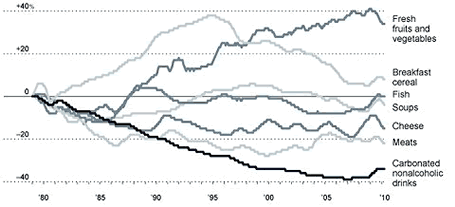
Source: NYT, BLS
It is pointed out that it costs about $5 to buy 2,000 calories at McDonald’s, $19 to buy 2,000 calories worth of canned tuna and $60 to buy 2,000 calories worth of lettuce.
But I’m not sure this means what we think it means. Do people really buy junk food because they need cheap calories? I think most unhealthy people get plenty of calories. Also, if you simply ate mostly rice and beans, you’d get plenty of calories for even less than McDonald’s. If all foods were the same price, would we really eat that much better? Perhaps it would help, but I don’t think lower prices would solve obesity.
I think the problem is people just eat what they want, and what they want happens to have way too many calories. If more health problems are caused by being overweight than malnutrition, then unhealthy people need less calories more than they need “better nutritional quality” calories. There are many studies that show that the less calories you eat, the longer you’ll live. Even severe calorie restriction (near-starvation) is believed to result in longer lives in a variety of animals including mice and monkeys.
What do people in countries where starvation is a real concern eat? Mostly rice with a little fish for flavor. Mostly beans and lentils with spices for flavor. Mostly cassava with a little meat and vegetables for flavor. They don’t eat a huge variety of things, and they eat mostly carbs. But they eat a lot less. If we can’t lower the prices of healthy unprocessed food, maybe we just need to eat less in general. But that takes self-control, which can also be hard to come by.


 You may have heard of a huge annual coupon book that is known simply as The Entertainment Book. Compiled specifically for your local area, it includes discounts for restaurants, movie tickets, movie attractions, and services like car repair or nail salons. The most common are 2-for-1 or 50% off. If you enter your zip code online, you’ll be able to see the coupons inside ahead of time. (Some people also buy books from tourist places like Orlando or Hawaii.)
You may have heard of a huge annual coupon book that is known simply as The Entertainment Book. Compiled specifically for your local area, it includes discounts for restaurants, movie tickets, movie attractions, and services like car repair or nail salons. The most common are 2-for-1 or 50% off. If you enter your zip code online, you’ll be able to see the coupons inside ahead of time. (Some people also buy books from tourist places like Orlando or Hawaii.)
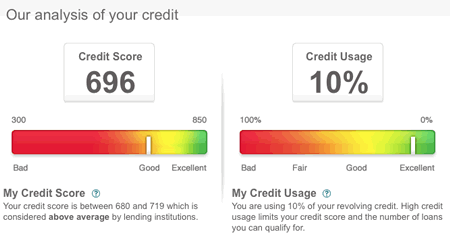
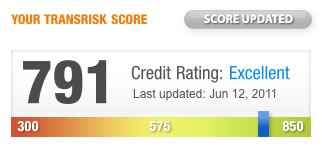

 I’ll be honest, I did not see the success of Netflix coming. I thought it was a nice, cute DVD rental business that would probably be bought out by Blockbuster eventually, leaving their founders stupendously rich. But look around today: Blockbuster is bankrupt, and Netflix now has more subscribers than any U.S. cable or satellite provider, including Comcast.
I’ll be honest, I did not see the success of Netflix coming. I thought it was a nice, cute DVD rental business that would probably be bought out by Blockbuster eventually, leaving their founders stupendously rich. But look around today: Blockbuster is bankrupt, and Netflix now has more subscribers than any U.S. cable or satellite provider, including Comcast.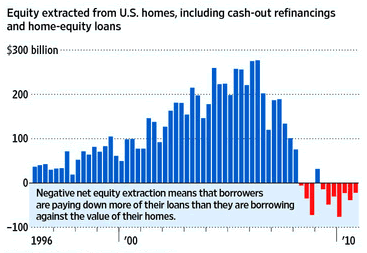
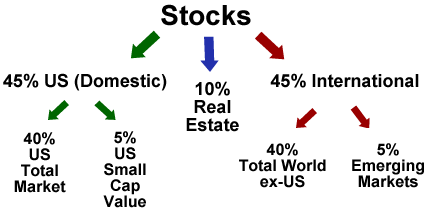
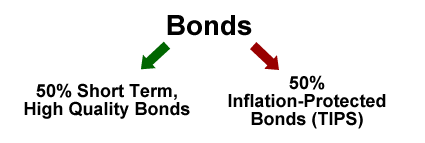
 Ready for the next new investing start-up idea? It’s “customer stock ownership plans” from
Ready for the next new investing start-up idea? It’s “customer stock ownership plans” from 
 The Best Credit Card Bonus Offers – March 2024
The Best Credit Card Bonus Offers – March 2024 Big List of Free Stocks from Brokerage Apps
Big List of Free Stocks from Brokerage Apps Best Interest Rates on Cash - March 2024
Best Interest Rates on Cash - March 2024 Free Credit Scores x 3 + Free Credit Monitoring
Free Credit Scores x 3 + Free Credit Monitoring Best No Fee 0% APR Balance Transfer Offers
Best No Fee 0% APR Balance Transfer Offers Little-Known Cellular Data Plans That Can Save Big Money
Little-Known Cellular Data Plans That Can Save Big Money How To Haggle Your Cable or Direct TV Bill
How To Haggle Your Cable or Direct TV Bill Big List of Free Consumer Data Reports (Credit, Rent, Work)
Big List of Free Consumer Data Reports (Credit, Rent, Work)